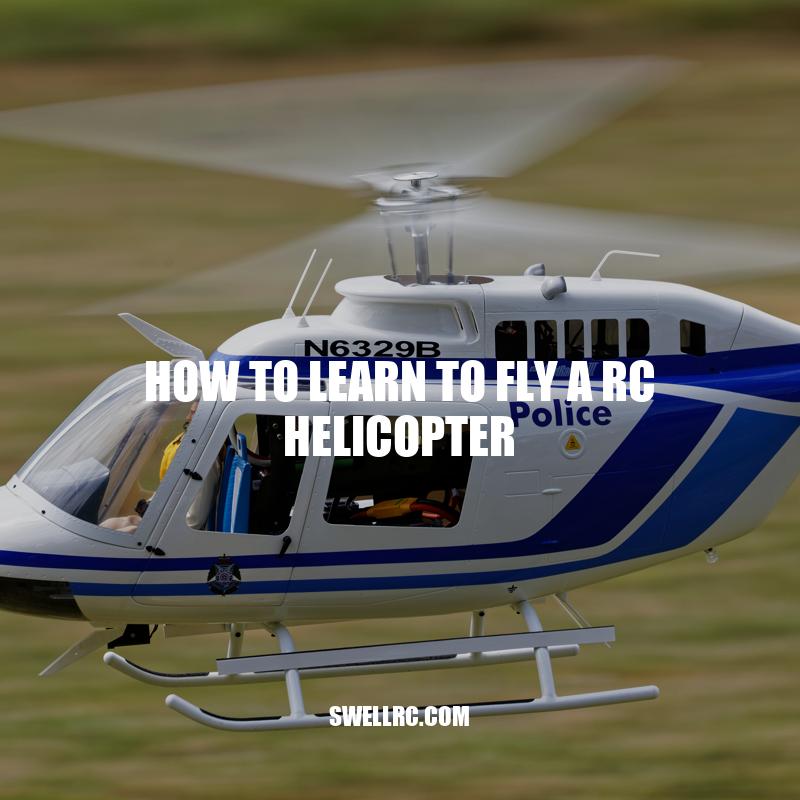Learn to Fly a RC Helicopter: A Comprehensive Guide
Learning how to fly a RC helicopter can be an exciting and thrilling hobby. However, it can also be a challenging and intimidating task for beginners. RC helicopters come in different types, sizes, and functions and require a certain level of skill and knowledge to operate. Before taking on this hobby, it’s essential to have a firm understanding of the basics of RC helicopters and the proper techniques for flying them. This article aims to provide a beginner’s guide on how to learn to fly a RC helicopter. From understanding the components of a helicopter and choosing the right one for your skill level to the best locations to practice flying and common mistakes to avoid, this guide will help you get started on the right foot. Whether you’re a complete novice to RC flying or an experienced pilot looking for tips, this article will equip you with the necessary knowledge and skills to fly a RC helicopter with confidence and ease.
Understanding the Basics
Before taking off, it’s crucial to have a basic understanding of RC helicopter components and functions. Here are a few essential points to keep in mind:
- The main rotor consists of blades attached to a hub on top of the helicopter and provides lift to the helicopter.
- The tail rotor counteracts the torque of the main rotor to keep the helicopter from spinning and allows it to turn.
- The swashplate controls the pitch, roll, and yaw movements of the helicopter.
- Practicing on a simulator can help you get comfortable with the controls before attempting to fly a real helicopter.
There are also many resources available online to help you learn more about RC helicopters, such as forums, videos, and manuals. Websites like Horizon Hobby, RC Groups, and RC Universe are great places to start. Additionally, some products like RealFlight and Phoenix RC simulate flying an RC helicopter on a computer and can help you learn and develop skills more quickly. Taking the time to research and understand the basics can help make the learning process smoother and more enjoyable.
What are the basic helicopter controls and functions?
- Main rotor – provides lift
- Tail rotor – counteracts the torque of the main rotor to keep the helicopter from spinning uncontrollably
- Collective – adjusts the pitch of the blades and controls the altitude of the helicopter
- Cyclic – changes the angle of the rotor blades to control the helicopter’s direction of flight
- Throttle – controls the engine power and therefore the speed of the rotor blades
Interested in learning more about helicopter controls and functions? Check out the FAA’s Helicopter Flying Handbook for a detailed guide.
Choosing the Right RC Helicopter
Choosing the right RC helicopter can significantly affect your learning process. Here are some things to consider when selecting a helicopter:
| Type | Features | Skill level |
|---|---|---|
| Indoor helicopters | Small and lightweight; designed for indoor use and lower speeds; less expensive than larger models. | Beginner |
| Outdoor helicopters | Larger and heavier; designed for more challenging outdoor flying conditions; more expensive than indoor models. | Intermediate/Advanced |
| Ready-to-fly helicopters | Include everything needed to start flying right away; straightforward setup and operation. | Beginner/Intermediate |
| Kit helicopters | Require more assembly and expertise to set up; allow for customization and modification. | Intermediate/Advanced |
It’s important to match your skill level with the appropriate helicopter. Starting with a smaller, indoor helicopter with features like a gyro stabilization system can make learning easier and more enjoyable. Additionally, there are many resources available online to help you select the right helicopter, such as websites like BestRC and RC Rank, which provide in-depth reviews and comparisons of different models.
Interestingly, many skilled RC helicopter pilots have gone on to fly real helicopters, making fundamentals covered here quite valuable in other aspects of aviation.
How to choose a motor for RC helicopter?
When it comes to choosing the right motor for your RC helicopter, there are a few important factors to consider:
- The size and weight of your helicopter
- The type of flying you’ll be doing (i.e. slow and steady or fast-paced aerobatics)
- The power output and efficiency of the motor
- The compatibility of the motor with your helicopter’s electronic speed controller (ESC)
It’s important to do your research and purchase a high-quality motor that’s designed specifically for use with RC helicopters. Two popular websites for purchasing RC helicopter motors and other components are HobbyKing and Horizon Hobby.
Remember, choosing the right motor is essential for ensuring high-quality flight performance and longevity for your RC helicopter.
Finding a Suitable Flying Location
Choosing an appropriate location to practice flying your RC helicopter is essential for both safety and enjoyment. Here are some tips for finding a suitable flying location:
- Look for a large, open and flat space with minimal obstacles.
- Avoid flying in crowded or public areas to minimize the risk of accidents or collisions.
- Consider joining a local RC flying club that may have access to established flying sites that are safe and suitable for beginners.
If you’re struggling to find a suitable location or are unsure about the regulations in your area, you can visit websites like the Academy of Model Aeronautics which provides guidelines and resources for finding and accessing suitable flying locations. Additionally, you can download apps like Airmap or Hover which provide flight restriction maps and real-time information about airspace regulations in your area.
How do you know where to go when flying a plane?
– Pilots use navigational instruments to determine their location and course while flying a plane.
– The most common instruments used for navigation are the magnetic compass, VOR (Very High Frequency Omnidirectional Range) receiver, GPS (Global Positioning System), and NDB (Non-Directional Beacon) receiver.
– Before takeoff, pilots plan their route and input their destination into the aircraft’s navigation system.
– During the flight, they use the instruments to confirm their location and adjust their course if necessary.
If you’re interested in learning more about flying and navigation, check out the resources available on websites such as FAA.gov or AOPA.org. There are also a variety of books and courses available, such as the “Private Pilot Manual” by Jeppesen or the “Sporty’s Learn to Fly” course.
Learning the Controls
Mastering the controls of your RC helicopter is fundamental to become a proficient pilot. Here are some tips to help you get a better understanding of the controls and improve your piloting skills:
- Start by learning the basic controls which typically consist of the throttle, yaw, pitch, and roll.
- Practice in all directions, meaning towards you, away from you, left and right.
- Begin with small movements and slowly increase the speed and complexity of your maneuvers as you become more comfortable with the controls.
- Use a simulator to practice your maneuvering skills in a virtual environment. A simulator will allow you to get accustomed to the feel of the controls without the risk of damaging your helicopter.
There are a variety of resources available online to help you better understand the controls of your RC helicopter. You can access instructional videos on websites such as YouTube or enroll in online courses offered by RC helicopter training schools. Additionally, many RC helicopter manufacturers offer online documentation and tutorials to help you better understand the controls and get started with your new helicopter.
What are the controls of the RC helicopter?
The controls of an RC helicopter are as follows:
- Throttle: Controls the speed of the rotors
- Pitch: Controls the angle of the main rotor blades, which in turn controls the altitude
- Yaw: Controls the tail rotor, which allows the helicopter to turn left or right
- Roll: Controls the movement of the helicopter from side-to-side
Additionally, some RC helicopters may have advanced features like 3D flight or GPS control. Understanding these controls is essential for successfully operating an RC helicopter.
If you’re interested in purchasing an RC helicopter, check out websites like Horizon Hobby or HobbyKing for a wide selection of models and accessories.
Common Mistakes to Avoid
Learning to fly a RC helicopter can be challenging, and it’s easy to make mistakes along the way. Here are some common mistakes to avoid and tips on how to recover from them:
- Overcorrecting your movements is a common mistake among beginners. You may be tempted to make large corrections when the helicopter doesn’t respond as expected. However, this can cause the helicopter to overreact and become difficult to control. Start with small corrections and adjust as necessary.
- Many new pilots make the mistake of flying too fast and attempting complicated maneuvers too soon. This can result in a crash, which can damage your helicopter and make it difficult to repair. Practice slow and precise movements until you’re comfortable with the controls.
- Another common mistake is not paying attention to the wind. Wind can quickly cause your helicopter to go off course, so it’s essential to monitor the conditions and adjust your movements accordingly.
- If you do make a mistake, it’s essential to remain calm and avoid panicking. Panic can cause overcorrection or a complete loss of control, leading to a crash. Instead, calmly assess the situation and try to make small adjustments to correct the helicopter’s trajectory.
There are resources to help you avoid these common mistakes such as instructional videos offered by experienced pilots on YouTube or forums where pilots can share tips and experiences. If you’re still struggling, consider signing up for a course offered by a professional RC helicopter training school or working with an experienced pilot to help you better understand the controls and improve your flying skills.
What are some common mistakes to avoid?
Here are some common mistakes to avoid when writing content:
- Not researching enough: It’s important to research the topic thoroughly before writing about it. This ensures your content is factual and helpful to your audience.
- Using complicated language: Avoid using complex language or using jargon that your audience may not understand. Keep it simple, yet engaging.
- Not proofreading: Always proofread your content before hitting publish. This helps to catch any spelling or grammatical errors and ensures your content looks professional.
- Not optimizing your content for SEO: SEO is important for getting your content seen by a larger audience. Use relevant keywords in your content and include meta descriptions and tags.
These mistakes can lead to a decrease in traffic, engagement, and conversions on websites or products. By avoiding these mistakes, you can create content that is informative, engaging, and effective.
Conclusion
Learning to fly a RC helicopter can be a fun and rewarding hobby. While it may take time and practice to master, by following the tips outlined in this guide, you can get started on your journey to becoming an expert pilot. Remember to be patient and take things slow as you familiarize yourself with the basics and work your way up to more advanced maneuvers. With enough dedication and practice, you’ll soon be flying your RC helicopter with confidence and skill.
Recommended Products:
- Blade Nano S2 – A beginner-friendly RC helicopter with a 3-axis gyro stabilization system
- Syma S107G – A budget-friendly option with a durable metal frame and easy-to-use controls
- DJI Mavic Mini – A more advanced option with 30-minute flight time, 4km HD Video Transmission, and 3-Axis Gimbal
Recommended Websites:
- RCGroups.com – An online community with forums, articles, and classifieds related to RC helicopters and other RC vehicles
- Helifreak.com – A forum-based website dedicated to RC helicopter enthusiasts with resources for both beginners and experienced pilots



